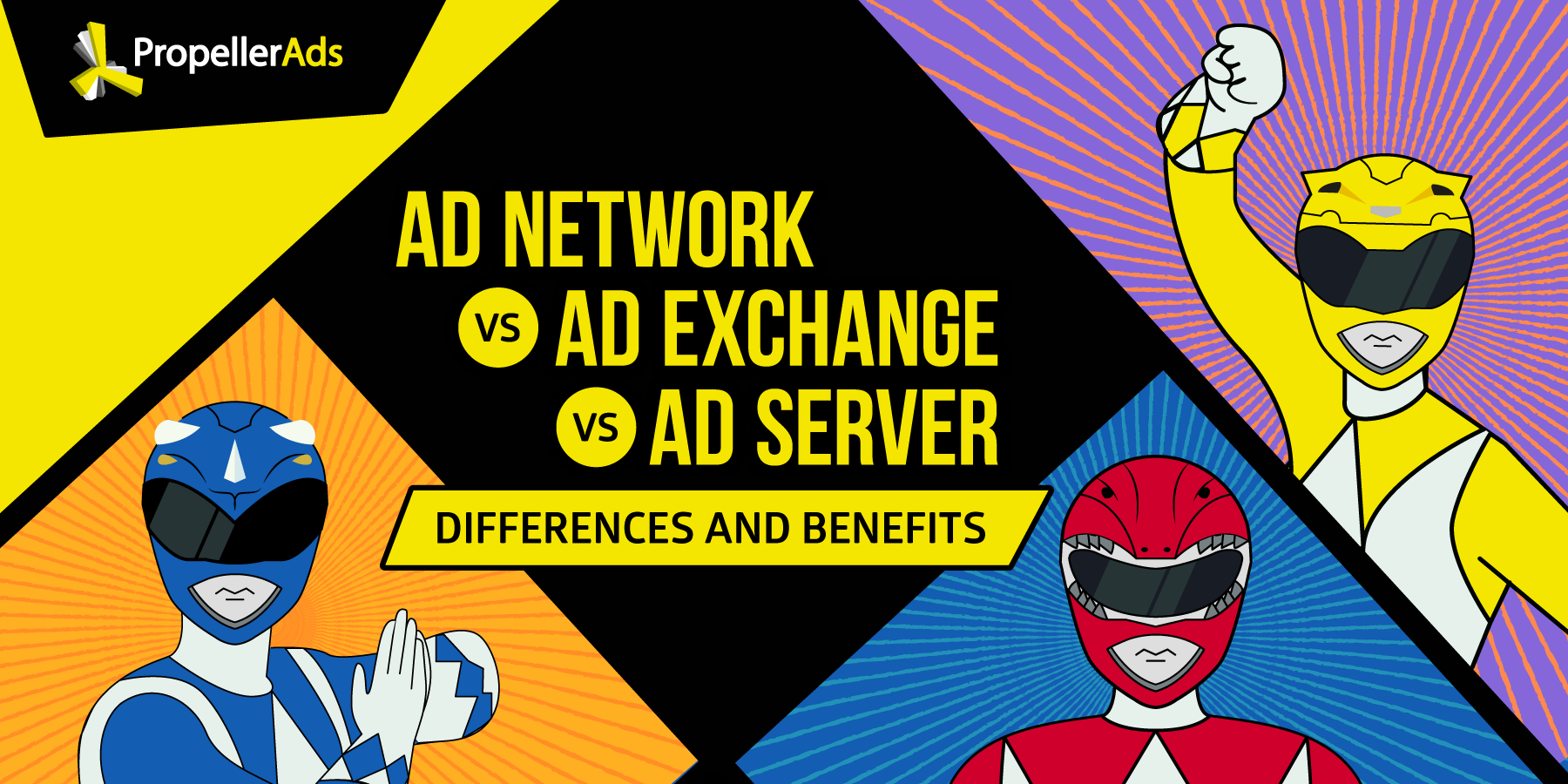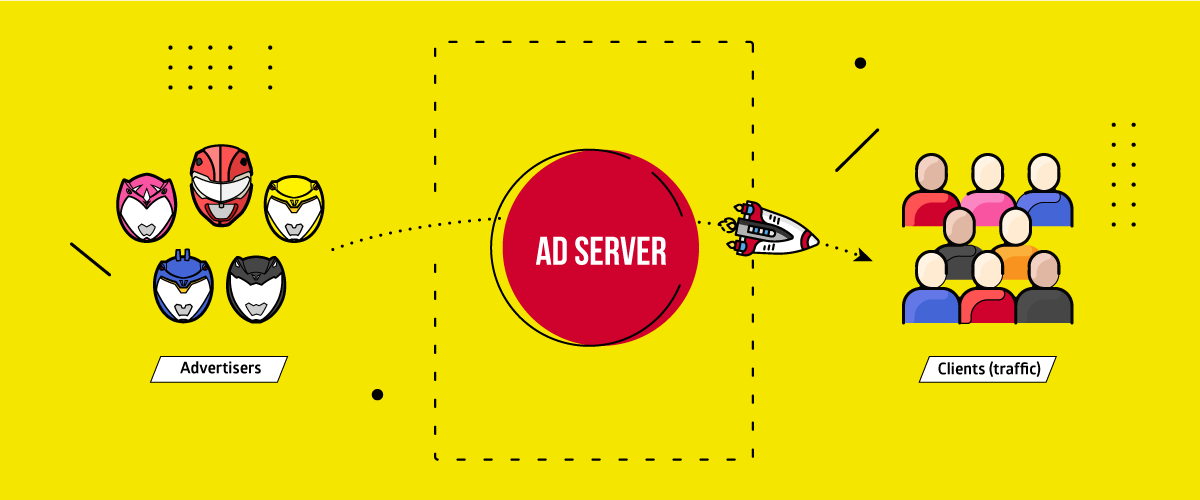Ad Network VS Ad Exchange VS Ad Server: Differences and Benefits

This post is also available in:
PT
ES
A long time ago, in those dark and ancient times, affiliates and publishers had to communicate by email. Can you imagine how hard it was for our ancestors to achieve their common goal (profit, of course) this way?
Well, luckily, ad networks, like PropellerAds, brought an end to those troublesome times. And this is when the great unity of advertisers and publishers began. But there were also ad exchanges and ad servers – they also played huge roles in history.
So, the time has come! Today, we are going to bring the end to that ad network VS ad exchange VS ad server confusion. We are here to fill the gaps in affiliates’ knowledge once and forever. Dive in, and let’s learn to differentiate terms!
What is an ad Network?
In general, ad networks ensure smooth communication between publishers and advertisers. Publishers provide their websites where the ads are shown (inventory or else – ad placements), and due to the ad networks technology, advertisers get the matching inventory that suits their needs.
Networks categorize inventory by audience types and ensure fast and efficient cooperation between publishers and advertisers.
So, basically, an ad network is a mediator that automizes, optimizes, and speeds up interaction between advertisers and publishers.
Which benefits do advertising networks offer?
Networks ensure that advertisers can reach:
Efficient tools and software for ad launch, analysis, and optimization as well as for inventory management – for instance, PropellerAds has a full pack of in-house software for efficient work of affiliates + multiple monetization options for publishers.
Managers – experienced managers help both advertisers and publishers get the most of their inventory and campaigns.
Various ad formats – in Propeller, we have Push ads, In-Page Push ads (IPP), Interstitial ads, and Popunder ads to choose from.
Automation – after an advertiser starts his campaign, the ad is placed on the relevant publisher’s ad space automatically. The auction-like process ensures that publishers get the desired price for their inventory, while advertisers receive the best inventory according to their budget.
At PropellerAds, both advertisers and publishers can benefit from the latest AI-based technologies, various ad formats for different purposes, creative templates, pricing models, and qualified assistance of the professional support team.
What is an ad Exchange?
While an ad network is a middle part between advertisers and publishers, ad exchange is rather a middle part between middle parts – namely, ad networks or large marketing agencies.
Here is how the exchange process works:
Say, there are two advertising networks. One of them has a lot of traffic (that doesn’t monetize properly), but a lack of advertisers. And the other one has the opposite problem – too many advertisers and a lack of traffic. The perfect scenario is to bring things to balance at both networks – each exchanges something surplus for something lacking.
So, these two can take part in an auction at the ad exchange and get what they need. In simple words, this is the process of getting or selling traffic from/to the outside on the basis of in-direct deals.
What about ad exchanges’ benefits?
Balancing traffic and advertisers – The purpose of ad exchanges is to bring things to balance and help the sides of a deal improve their work process or else – at least keep publishers on their platforms even if the deal doesn’t bring too much extra profit.
Smart bidding – To sell traffic, advertising networks like Propeller usually stick to RTB (real-time bidding). This is the process of selling/buying based on the high-tech exchange’s engine, able to evaluate and bid on every available impression.
To buy traffic, we usually stick to DSP (demand-side platform), where it is possible to get ad space from a number of suppliers, which can include other networks, large individual publishers, and ad agencies. Both sides of the deal can set preferred prices and other requirements for the best match.
Personally, PropellerAds usually sells Onclick, Push, and In-page push (IPP) traffic at ad exchanges.
The tiny conclusion: Ad networks and ad exchanges are similar, and they usually act as parts of a single process. Both are mediums that smoothen and optimize programmatic ad buying and selling. The key difference – ad networks usually serve publishers and advertisers, while ad exchanges are mostly for networks and agencies. The principle stays the same – automatization and optimization of ad selling/buying to make the deals as winning for both sides as possible.
See the infographics to grasp the idea:

What is an Ad Server?
While ad networks and exchanges can be compared in some respects, ad servers are a bit another story. An ad server is a more abstract entity – it’s not a platform. It’s rather a technology that stands behind ad networks’ software and actually makes everything work properly.
An ad server is where our software operates – it ensures the proper functioning of advertisers’ accounts at ad networks, like PropellerAds.
What are the benefits of ad servers?
It’s hard to talk about the benefits of ad servers, since they just do the job, but we will highlight a couple of points to remember:
Ad servers help advertisers get relevant traffic – mostly, they ensure the most optimal match by non-person targeting settings, like GEO, platform, iOS, etc.
Also, servers ensure efficient communication between advertisers and their audience (traffic). In simple words, they make everything work as an advertiser wants to, when he is rolling the ads.

Let’s conclude
See? Everything is not as complicated as it seems. Now you know that:
- Ad network serves advertisers and publishers to make their interaction maximally efficient and optimal. It helps both sides get the best deals and reach their monetization goals by means of advanced tools, customer support, and fully-equipped accounts for proper work. The ad network is a medium between publishers and advertisers.
- Ad exchange is a medium between ad networks, agencies, and large publishers. It helps the parties buy/sell traffic or ads, regarding their needs. For the best work, advertising networks should have an equal amount of traffic and advertisers; that is why it is so important to keep everything balanced. And ad exchanges help them reach it.
- Ad server is software that stands behind all processes within the ad network and ensures proper functioning of accounts, as well as communication between advertisers and their audiences.
That’s all for today. Keep the differences between terms in mind – let affiliate marketing literacy be your light!
Let’s discuss this and other affiliate marketing topics in our cozy Telegram chat!



